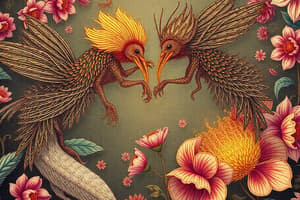Podcast
Questions and Answers
Daughter cells are half the parent’s ______ size
Daughter cells are half the parent’s ______ size
parent's
In bacteria, cells reproduce through _______________ reproduction
In bacteria, cells reproduce through _______________ reproduction
asexual
In ______ and hydra, budding is a type of asexual reproduction
In ______ and hydra, budding is a type of asexual reproduction
yeast
Regeneration is a type of asexual reproduction that allows ______ to repair or grow lost body parts
Regeneration is a type of asexual reproduction that allows ______ to repair or grow lost body parts
Daughter cells grow, then divide too, in the process of ______ reproduction
Daughter cells grow, then divide too, in the process of ______ reproduction
Asexual reproduction occurs in _______________ such as yeast and hydra.
Asexual reproduction occurs in _______________ such as yeast and hydra.
During budding, a small _______________ grows out of the parent cell.
During budding, a small _______________ grows out of the parent cell.
Daughter cells are made through _______________ reproduction.
Daughter cells are made through _______________ reproduction.
Regeneration is a type of asexual reproduction that allows _______________ to regrow lost body parts.
Regeneration is a type of asexual reproduction that allows _______________ to regrow lost body parts.
In regeneration, leftover cells _______________ to make more cells.
In regeneration, leftover cells _______________ to make more cells.
Asexual reproduction produces offspring with the same ______ as the parent.
Asexual reproduction produces offspring with the same ______ as the parent.
In sexual reproduction, the offspring have mixed ______ from the two parents.
In sexual reproduction, the offspring have mixed ______ from the two parents.
Fertilization is the process of a male and female ______ cell combining to form a new cell.
Fertilization is the process of a male and female ______ cell combining to form a new cell.
Binary fission is a type of asexual reproduction in which an organism divides into two ______ daughter cells.
Binary fission is a type of asexual reproduction in which an organism divides into two ______ daughter cells.
Asexual reproduction can occur through ______, such as budding in plants and animals.
Asexual reproduction can occur through ______, such as budding in plants and animals.
Study Notes
Asexual Reproduction
- Involves one parent
- No sex cells are produced
- Offspring are produced by cell division
- Offspring are identical to the parent, having the same DNA
- Several types of asexual reproduction exist in plants and animals
Types of Asexual Reproduction
-
Binary Fission
- Organism divides in half
- 2 identical daughter cells are produced
- Daughter cells are half the parent's size
- Daughter cells grow and then divide too
- Occurs in bacteria
-
Budding
- A small bud grows out of the parent cell
- Two different sized cells are made, with identical DNA
- The bud breaks off and grows
- Occurs in yeast and hydra
-
Regeneration
- Involves repairing or growing lost body parts
- Leftover cells divide to make more cells
- Occurs in lobsters, starfish, and lizards
Sexual Reproduction
- Involves 2 parents
- Sex cells (sperm and egg) are produced
- Sperm and egg join during fertilization
- Offspring look different from the parents, having mixed DNA
- Examples include humans, some plants, mammals, fish, reptiles, etc.
Fertilization
- Part of the process of sexual reproduction
- A male reproductive cell and a female reproductive cell combine
- Forms a new cell that can develop into a new organism
Asexual Reproduction
- Involves one parent
- No sex cells are produced
- Offspring are produced by cell division
- Offspring are identical to the parent, having the same DNA
- Several types of asexual reproduction exist in plants and animals
Types of Asexual Reproduction
-
Binary Fission
- Organism divides in half
- 2 identical daughter cells are produced
- Daughter cells are half the parent's size
- Daughter cells grow and then divide too
- Occurs in bacteria
-
Budding
- A small bud grows out of the parent cell
- Two different sized cells are made, with identical DNA
- The bud breaks off and grows
- Occurs in yeast and hydra
-
Regeneration
- Involves repairing or growing lost body parts
- Leftover cells divide to make more cells
- Occurs in lobsters, starfish, and lizards
Sexual Reproduction
- Involves 2 parents
- Sex cells (sperm and egg) are produced
- Sperm and egg join during fertilization
- Offspring look different from the parents, having mixed DNA
- Examples include humans, some plants, mammals, fish, reptiles, etc.
Fertilization
- Part of the process of sexual reproduction
- A male reproductive cell and a female reproductive cell combine
- Forms a new cell that can develop into a new organism
Studying That Suits You
Use AI to generate personalized quizzes and flashcards to suit your learning preferences.
Related Documents
Description
Learn about the differences between asexual and sexual reproduction, including definitions and illustrations of each process. Compare and contrast these two types of reproduction methods.




